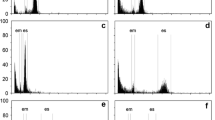Abstract
Reproductive behaviour and the pathways of gene flow among ploidy levels were studied experimentally inTaraxacum sect.Ruderalia. Diploid, triploid and tetraploid individuals were sampled from mixed diploid — polyploid natural populations. 136 experimental hybridizations between the plants of different ploidy levels were performed. Seeds resulting from these crosses, those obtained from isolated anthodia as well as from open pollinated anthodia (both from cultivated and wild plants) were subjected to the flow-cytometric seed screening (FCSS) to determine ploidy levels in the progeny and to infer breeding behaviour of maternal plants. Three possible pathways of the gene flow were studied: (A) fertilization of sexuals by pollen of apomicts, (B) BIII hybrid formation, (C) facultative apomixis. Diploid maternal plants when experimentally crossed with triploid pollen donors produced diploids and polyploid progeny, while when pollinated with a mixture of the pollen of diploids and triploids or insect pollinated, no polyploids were discovered. It seems that in the mixture with the pollen of diploids, the pollen of triploids is ineffective. Tetraploids produce hybrids much easier with diploid mothers and their role in wild populations requires further study. Triploid mothers, even those with subregular pollen did not show traces of facultative apomixis. BIII hybrids were present in the progeny of both triploids and tetraploids, in tetraploids in quite high percentages (up to 50% of the progeny in some crosses).
Similar content being viewed by others
References
Asker S.E. &Jerling L. (1992):Apomixis in plants. CRC Press, Boca Raton, Ann Arbor, London, Tokyo.
Doll R. (1982): Grundriss der Evolution der GattungTaraxacumZinn.Feddes Repert. 93: 481–624.
Fürnkrantz D. (1961): Cytogenetische Untersuchungen anTaraxacum im Raume von Wein. II. Hybriden zwichenT. officinale undT. palustre.Oesterr. Bot. Z. 108: 408–415.
Hughes J. &Richards A.J. (1988): The genetic structure of populations of sexual and asexualTaraxacum (dandelions).Heredity 60: 161–171.
Jenniskens M.P.J., den Nijs J.C.M. &Sterk A.A. (1985): Crossability and hybridization of taxa ofTaraxacum sectionTaraxacum from central and western Europe.Proc. Kon. Ned. Akad. Wetensch. C 88: 297–338.
Kirschner J. &Štěpánek J. (1996): Modes of speciation and evolution of the sections inTaraxacum.Folia Geobot. Phytotax. 31: 415–426.
Kipschner J. &Štěpánek J. (1998): A monograph ofTaraxacum sect.Palustria. Institute of Botany, Průhonice.
Kirschner J. &Štěpánek J. (2004): New sections inTaraxacum.Folia Geobot. 39: 259–274.
Małecka J. (1965): Embryological studies inTaraxacum palustre.Acta Biol. Cracov., Ser. Bot. 8: 223–235.
Małecka J. (1967): Processes of intraspecific differentiation in the genusTaraxacum.Genet. Polon. 8: 185–188.
Małecka J. (1973): Problems of the mode of reproduction in microspecies ofTaraxacum sectionPalustriaDahlstedt.Acta Biol. Cracov., Ser. Bot. 16: 37–84.
Matzk F., Meister A. &Schubert I. (2000): An efficient screen for reproductive pathways using mature seeds of monocots and dicots.Pl. J. 21: 97–108.
Matzk F., Meister A., Brutovská R. &Schubert I. (2001): Reconstruction of reproductive diversity inHypericum perforatum L. opens novel strategies to manage apomixis.Pl. J. 26: 275–282.
Menken S.B.J., Smit E. &den Nijs J.C.M. (1995): Genetical population structure in plants: gene flow between diploid sexual and triploid asexual dandelions (Taraxacum sectionRuderalia).Evolution 49: 1108–1118.
Meirmans P.G., Vlot E.C., den Nijs J.C.M. &Menken S.B.J. (2003): Spatial ecological and genetic structure of a mixed population of sexual diploid and apomicitic triploid dandelions.J. Evol. Biol. 16: 343–352.
Mogie M. &Ford H. (1988): Sexual and asexualTaraxacum species.Biol. J. Linn. Soc. 35: 155–168.
Morita T., Menken S.B.J. &Sterk A.A. (1990a): Hybridization between European and Asian dandelions (Taraxacum sectionRuderalia and sectionMongolica). 1. Crossability and breakdown of self-incompatibility.New Phytol. 114: 519–529.
Morita T., Sterk A.A., den Nijs J.C.M. (1990b): The significance of agamospermous triploid pollen donors in the sexual relationship between diploids and triploids inTaraxacum (Compositae).Pl. Spec. Biol. 5: 167–176.
Murín A. (1960): Substitution of cellophane for glass covers to facilitate preparation of permanent squashes and smears.Stain Technol. 35: 351–353.
Richards A.J. (1970a): Hybridization inTaraxacum.New Phytol. 69: 1103–1121.
Richards A.J. (1970b): Eutriploid facultative agamospermy inTaraxacum.New Phytol. 69: 761–774.
Richards A.J. (1973): The origin ofTaraxacum agamospecies.Bot. J. Linn. Soc. 66: 189–211.
Richards A.J. (1997):Plant breeding systems. Ed. 2. Chapman & Hall, London, etc..
Sorensen T. (1958): Sexual chromosome aberants in triploid apomictic Taraxaca.Bot. Tidsskr. 54: 1–22.
Sterk A.A. (1987): Aspects of the population biology of sexual dandelions in the Netherlands. In:Huiskes A.H.L., Bloom C.W.P. M. &Rozema J. (eds.),Vegetation between land and sea, Junk Publishers, Dordrecht, pp. 284–291.
Tas I.C.Q. &van Dijk P.J. (1999): Crosses between sexual and apomictic dandelions (Taraxacum). I. The inheritance of apomixis.Heredity 83: 707–714.
Tchermak-Woess E. (1949): DiploidesTaraxacum vulgare in Wien und Niederösterrrieich.Oesterr. Bot. Z. 96: 56–63.
Uhlemann I., Kirschner J. &Štěpánek J. (2004): The genusTaraxacum (Asteraceae) in the southern Hemisphere. I. The sectionAntarcticaHandel-Mazzetti and notes on dandelions of Australasia.Folia Geobot. 39: 205–220.
van Baarlen P., de Jong J.H. &van Dijk P.J. (2002): Comparative cyto-embryological investigations of sexual and apomictic dandelions (Taraxacum) and their apomictic hybrids.Sex. Pl. Reprod. 15: 31–38.
van Dijk P.J., Tas I.C.Q., Falque M. &Bakx-Schotman T. (1999): Crosses between sexual and apomictic dandelions (Taraxacum). II. The breakdown of apomixis.Heredity 83: 715–721.
Záveský L., Jarolímová V. &Štěpánek J. (2005): Nuclear DNA content variation within the genusTaraxacum (Asteraceae).Folia Geobot. 40: 91–104.
Author information
Authors and Affiliations
Rights and permissions
About this article
Cite this article
Mártonfiová, L. Possible pathways of the gene flow inTaraxacum sect.Ruderalia . Folia Geobot 41, 183–201 (2006). https://doi.org/10.1007/BF02806478
Received:
Revised:
Accepted:
Issue Date:
DOI: https://doi.org/10.1007/BF02806478




